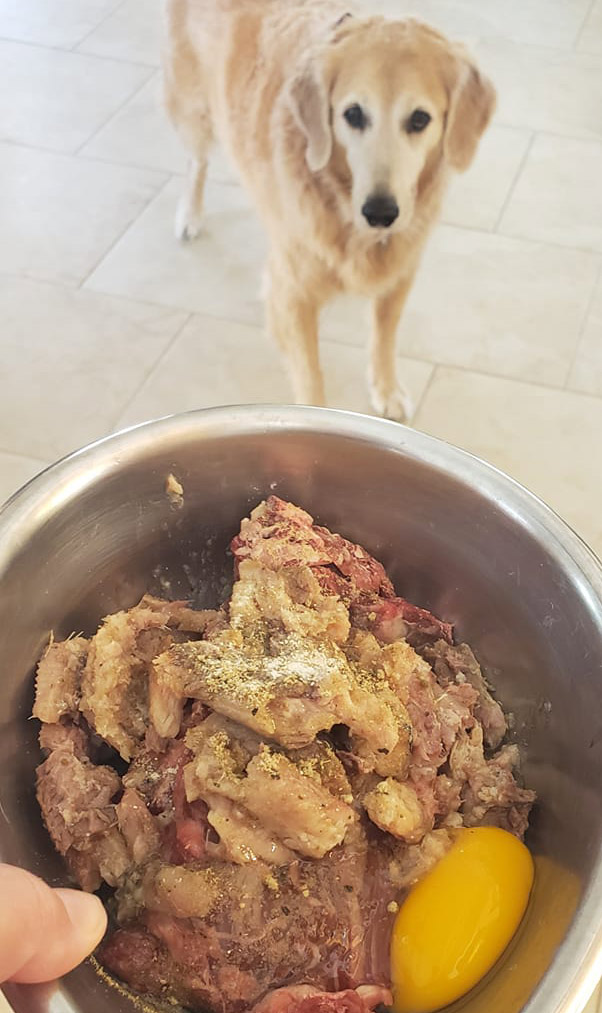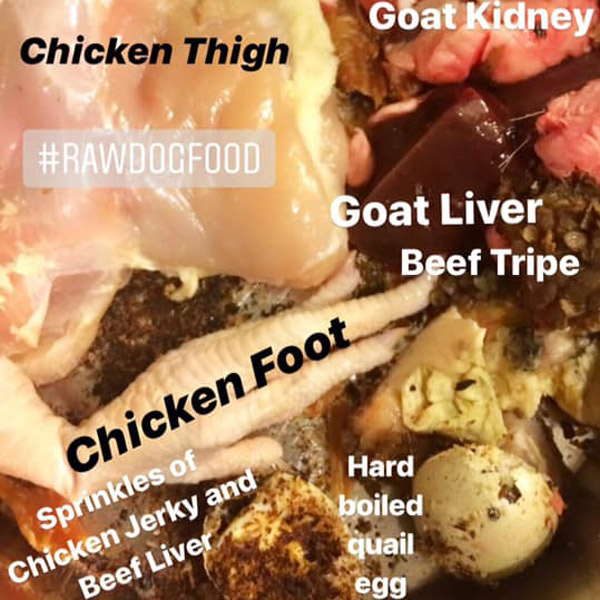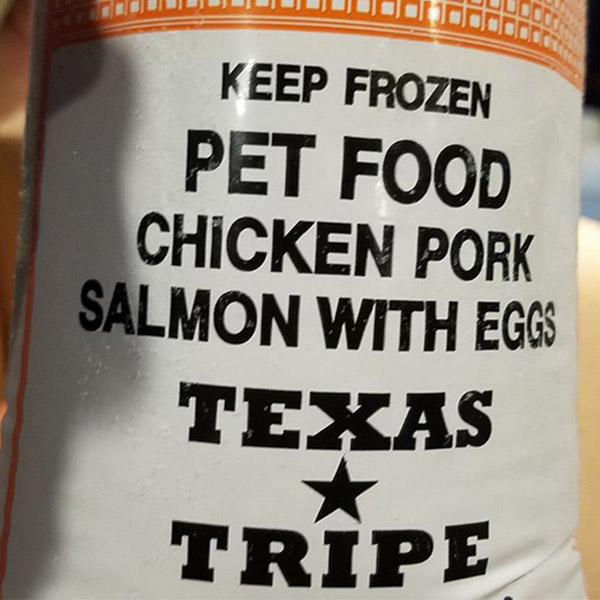Raw Food Diet Dog Percent
What is a raw dog food diet?
A raw dog food diet consists of meals that are freshly prepared at home and contain a variety of fresh ingredients such as uncooked meat like muscle and organ tissue, bones that are either whole or crushed, fruit, vegetables, and occasionally dairy, including eggs.
Primarily, there are two popular schools of thought regarding raw feeding.
The first, known as the "Prey" model, is said to represent the type of diet a dog would have if they lived in the wild and hunted for their food. This method typically consists of 80% muscle meat, 10% bone, and 10% organs (half of which is liver.)
The second popular raw feeding method is referred to as "BARF: Biologically Appropriate Raw Food." First coined by Australian veterinarian Ian Billinghurst in 1993, the "BARF" method of raw feeding similarly reflects the way a dog would eat if they were not domesticated. The diet is slightly different from the "Prey" method in that it leaves room for additional ingredients such as vegetables, fruit, and seeds. The ratio for "BARF" raw feeding is 70% muscle meat, 10% raw edible bone, 5% liver, 5% other secreting organs, 7% vegetables, 2% seeds or nuts, and 1% fruit.
According to Billy Hoekman, the Natural Science Coordinator for Answers Pet Food, dogs are facilitative carnivores. This means they eat mostly meat and some fruits and vegetables. Hoekman recommends a diet of mostly meat, with less than 10% of caloric intake being provided by plants. He also suggests adding unprocessed foods such as raw milk and eggs.

Why are pet parents turning to raw food?
The theory regarding raw feeding for pets is that dogs have been eating raw food far longer than then they have been eating mass-produced, processed food such as canned meals and dry kibble. The processed food industry didn't start mass-producing dog food until the 1950s-1960s, but dogs have been eating raw food for thousands of years throughout their evolution from wolves.
Pet parents also claim that after their transition into raw feeding, their pets have benefitted dramatically in terms of their health, quality of life, and more.
In Dr. Billinghurst's book Give Your Dog a Bone, he states that after experimenting with a raw diet on his own dogs, he immediately noticed that their skin problems cleared up, there was a decrease in dental and eye problems, the dogs experienced better growth and reproductive success, and more.
We spoke with The Pet Gal's resident raw feeding experts about their experiences with raw food and asked how their pets' lives were improved. Here's what they had to say:
Every time my dog, Ditka, went off antibiotics she would pick up another bacterial infection and get another case of diarrhea. We washed her, wiped her, and kept her away from high bacteria environments, but she still kept getting sick. We were spending close to $250 a month on veterinarian bills, stool samples, and antibiotics. We needed a veterinarian who would look at this problem a whole new way. We consulted a holistic veterinarian, and she started us on the process of slowly changing our dog to a raw diet and adding vegetables and supplements to boost her immune system. Within a month, Ditka slimmed down, had a shinier coat, increased energy, and she hasn't had an infection in almost one and a half years. The transformation from a very sick to a healthy dog in a short period of time was astounding. Changing our dog Ditka from kibble to a raw food diet saved her life by boosting her immune system and giving her the healthy nutrients she needs. – Pet Gal Laura
Raw feeding not only opened up a world of health for my dogs, past and present, but it also opened up a whole new interest in pet nutrition on my part.
When I first began feeding raw, I thought giving my dogs raw chicken legs was enough. After researching the topic and joining a raw feeding coop, however, I became much more aware of my dogs' nutritional needs. We humans like to say, 'You are what you eat,' and, 'Food is medicine,' but this is true of our animal friends, too!
I am now taking coursework in pet nutrition, which I hope will benefit not only my pets but those of our clients.
I had a geriatric pack of three, and they all lived long healthy lives. I attribute this to proper raw feeding, as well as the implementation of other holistic practices. I have high expectations for my current pack, raised on raw food since puppyhood! – Pet Gal Debbie

What are the benefits of raw food?
Stories like the ones above have led more owners to change their dogs from kibble to a raw diet. Pet parents claim that the benefits of raw feeding run the gamut from digestion and dental health to disease prevention. Listed below are some research-backed benefits of a canine raw diet.
Easier Digestion
Dr. Richard Patton, an animal nutritionist for over 40 years, has found that raw food is often easier to digest than processed kibble. When dog food kibble is created, many of the nutrients are taken away during the processing and cooking of the food, making it more difficult for your dog to digest. In Dog's Naturally Magazine, Dr. Patton calls this process "protein denaturation" and says during this time the proteins, and many of the good bacteria for our gut are killed. In comparison, he points out that "natural enzymes and numerous beneficial bacteria are found in raw pet foods."
Weight Management
Dr. Patton explains that additives that are introduced to processed pet food have led to a higher carbohydrate and sugar content in the kibble, which can lead to weight gain. In addition, processed dog food has had its important nutrients stripped.
Personally, I have seen dogs who wouldn't touch their kibble gobble down their raw food when they made the switch. Even though they were eating more food, they were slimming down because they were eating more proteins and fewer carbohydrates and sugars.– Pet Gal Laura
Better Stools
Dr. Patton says that when the food is more digestible, dogs will have healthier and smaller stools. This claim was also backed by Dr. Billinghurst (Give Your Dog a Bone), who added that his dogs' stools were less smelly after they began eating raw.
Increased Energy
Dr. Billinghurst also noted in his book that his dogs experienced an energy increase after changing to a raw diet. Other pet parents have said the same. The theory regarding this is that carbohydrates and sugars in kibble give your dog an energy spike, which is followed by a plunge into tiredness. Raw food advocates say that raw food reduces energy spikes, giving dogs more consistent energy levels.
Preventing Diseases
Dr. Jean Hofve, a Holistic Veterinarian and Dr. Peter Dobias, has found that changing a dog's diet can help prevent some of the risk factors associated with canine diabetes and other related conditions. Dr. Dobias says that since he started recommending raw diets to his clients, the incidence of pancreatitis cases has decreased drastically in his veterinary practice.
Dog food kibble is heat processed and tends to be high in sugar and carbohydrates, which are all risk factors for canine diabetes, pancreatitis, and weight gain. Raw diets tend to have lower carbohydrates, lower sugars, and higher proteins, meaning dogs are less likely to be overweight. Similar to humans, obesity in animals can predispose them to more diseases.
Other benefits that pet owners have attributed to raw feeding include better teeth and dental hygiene, shinier coat, healthier skin, fewer food allergies, and a boosted immune system.

What is the correct way to feed raw?
When changing your dog to a raw food diet, you must do it the right way.
As with any dietary change, the transition to raw should be done slowly. It is recommended that a Certified Animal Dietician or Holistic/Integrative Veterinarian help you design a raw diet plan and transition schedule that is individualized to your dog.
In addition, it's crucial to ensure your dog's raw food has adequate nutritional balance. Raw food manufacturers offer pre-made mixes that contain all the essential nutrients, but many people prefer to make their own raw food for their pets. Whether you purchase your raw food or make it yourself, it's crucial to have the correct mix of proteins, vegetables, and other nutrients. Consulting with an expert and making sure you purchase high-quality food are very important steps.
Veterinarian Dr. Katie Grzyb states there are a few common mistakes people tend to make when switching their dog to raw food. The biggest of which is that they don't understand the basics of pet nutrition. Some people fail to realize that raw food is more than just meat. Raw food should also include many other ingredients, such as eggs, fruits, vegetables, and supplements such as Omega 3 oils. These ingredients together can provide all the nutrients that dogs need.
Consult with a professional who can help you understand your pet's nutritional needs.
The most important part of doing a fresh or raw diet is balance. A lot of people have a misconception about raw diets. They think if you feed meat, bone, and organs, it's a complete diet. It's not. If a dog were to catch an animal, they would also be eating the fur/feathers, and sometimes dogs can be found grazing on fruit. A lot of meat we purchase in the stores are lacking certain macro and micronutrients due to the environment they are raised in and their nutrition. Therefore, it is important to supplement. I love using bioavailable foods such as mussels, oysters, sardines, fermented seeds and nuts, kelp, and veggie blends to fill in the gaps. – Meghan Jerolaman, Lava Paws
Another vital factor in raw feeding is protein variety. Dogs and cats should have a variety of 5 proteins (fish not included). Protein rotation helps with boredom and getting a wide range of nutrients (every meat provides different nutrients).
What precautions should pet parents take when considering raw food?
Some of the most widely discussed criticisms of raw feeding are the concern of foodborne illness due to ingesting bacteria from raw food and the potential for cross-contamination to humans when preparing raw meals. However, supporters of the raw food movement point out that many processed pet foods, including kibble and canned food, can also contain salmonella and E.coli bacteria.
Pet owners need to make the decision that is best for their pet based on research and conversations with their vet. It is equally as important that those who choose raw food make sure that the ingredients are from a reputable source that prioritizes safety standards and only sells high-quality meat.
The final thing to remember is to follow the same guidelines as handling raw meat you consume. Raw meats contain bacteria, so it's also important to keep both you and your animals safe. Here are some helpful safety guidelines:
Store raw food in sealed containers in the freezer.
keep raw food separate from other food by using different containers.
When placing the food in the refrigerator, keep the temperature below 40°F and only store 2-3 days' worth of food. Like meat that would be used for human dinners, if raw food is in the refrigerator too long, it can get harmful bacteria and should be thrown out.
If taking raw food out of refrigerator to let it come to room temperature before feeding, limit the time the food is out of the fridge.
If your dog hasn't eaten the raw food in a couple of hours, throw it out.
When handling raw food, wash your hands thoroughly afterward.
Clean all cutting boards, utensils, and countertop surfaces thoroughly after handling raw food.
Dr. Richard Patton states that if pet owners don't want to feed straight raw, they should consider freeze drying food, a process that helps preserves nutrients and good bacteria much better than cooking.
Local Raw Feeding Resources
Whether you're just starting to feed your pet raw food or are looking to find a community of like-minded raw feeders, getting educated and connecting with others are great ways to integrate raw feeding into your life further.
To learn more about raw feeding, consider reading Give Your Dog a Bone by Dr. Ian Billinghurst or Dr. Becker's Real Food For Healthy Dogs & Cats: Simple Homemade Food by Karen Becker, DVM.
Austin, Texas
For those who live in Austin and the surrounding areas, check out the Austin Raw Feeders Co-op (ARF), a purchasing cooperative for people in the Austin area. The group is an excellent way to connect with other pet parents who choose to feed raw and can be helpful toward lowering the costs of raw food, as the co-op makes bulk food purchases from a variety of suppliers.
If you're looking to make the switch to raw food but don't have the time to make it yourself, consider finding a local raw food supplier or check with your local specialty pet store for frozen, ready-to-use products. Texas Tripe is a Texas-based company that supplies affordable, "Prey" model food and Tomlinson's carries "BARF" model food from Steve's Real Food.
Kona, Hawaii
We spoke with Meghan Jerolaman at Lava Paws in Kona about her upcoming raw food products.
Lava Paws is a developing business whose goal is to be a one-stop-shop for all raw feeding needs. Currently, they offer dehydrated meat treats for dogs and cats (muscle meat or cartilage), but eventually, they hope to provide meat, bones, organs, veggies, ferments, vitamin supplements, and much more.
Until then, Meghan does consultation diet plans for pet parents who feed raw. If you are interested in a consult with Meghan, visit the Lava Paws website and submit a contact form or email info@lavapaws.com.
Pawniolo Pets is a new pet food company run by husband and wife team Nick and Miki. Based in Waimea, all of their pet food products are produced and processed on their family cattle ranch using only grass-fed beef. They make a meat blend consisting of 90% lean ground beef, and 10% ofal meat (liver, kidney, spleen, lung), as well as, several other products. You can get more information by calling them at 808.389.3789 or at the Waimea Midweek Farmers Market (open Wednesdays from 9 am -2 pm) at Pukalani Stables.
Kona Raw Pet Food Co-op is based in Kona and provides members with a wide variety of food products from Hawaii Beef Producers. Unlike, many of the mainland raw food producers all Kona Raw is human grade without antibiotics. Additionally, the product is in whole form requiring the purchaser to butcher it down to the correct weight. For example, you purchase a ten-pound cow heart and butcher it into quarter-pound meals for a 60-pound canine.
Colorado Springs, Colorado
For pet parents in Colorado Springs and nearby areas, Raw Dog Food and Company is a direct-to-consumer raw food provider based out of Colorado. They sell high-quality, small-batch, and handcrafted raw dog food in a variety of blends.
When first beginning with raw food, it can be great to connect with locals in your area who are passionate about raw feeding. We suggest reaching out to find local groups or local pet stores and getting as much information as you can about the raw food scene in your area.
article by Pet Gal Kirstie.
Source: https://thepetgal.com/raw-dog-food/

0 Response to "Raw Food Diet Dog Percent"
Post a Comment